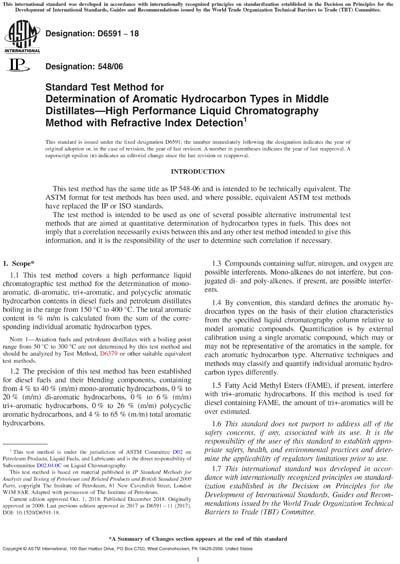Historical
ASTM D6591-18
Standard Test Method for Determination of Aromatic Hydrocarbon Types in Middle Distillates - High Performance Liquid Chromatography Method with Refractive Index Detection
1.1 This test method covers a high performance liquid chromatographic test method for the determination of mono-aromatic, di-aromatic, tri+-aromatic, and polycyclic aromatic hydrocarbon contents in diesel fuels and petroleum distillates boiling in the range from 150 °C to 400 °C. The total aromatic content in % m/m is calculated from the sum of the corresponding individual aromatic hydrocarbon types.
Note 1: Aviation fuels and petroleum distillates with a boiling point range from 50 °C to 300 °C are not determined by this test method and should be analyzed by Test Method, D6379 or other suitable equivalent test methods.
1.2 The precision of this test method has been established for diesel fuels and their blending components, containing from 4 % to 40 % (m/m) mono-aromatic hydrocarbons, 0 % to 20 % (m/m) di-aromatic hydrocarbons, 0 % to 6 % (m/m) tri+-aromatic hydrocarbons, 0 % to 26 % (m/m) polycyclic aromatic hydrocarbons, and 4 % to 65 % (m/m) total aromatic hydrocarbons.
1.3 Compounds containing sulfur, nitrogen, and oxygen are possible interferents. Mono-alkenes do not interfere, but conjugated di- and poly-alkenes, if present, are possible interferents.
1.4 By convention, this standard defines the aromatic hydrocarbon types on the basis of their elution characteristics from the specified liquid chromatography column relative to model aromatic compounds. Quantification is by external calibration using a single aromatic compound, which may or may not be representative of the aromatics in the sample, for each aromatic hydrocarbon type. Alternative techniques and methods may classify and quantify individual aromatic hydrocarbon types differently.
1.5 Fatty Acid Methyl Esters (FAME), if present, interfere with tri+-aromatic hydrocarbons. If this method is used for diesel containing FAME, the amount of tri+-aromatics will be over estimated.
1.6 This standard does not purport to address all of the safety concerns, if any, associated with its use. It is the responsibility of the user of this standard to establish appropriate safety, health, and environmental practices and determine the applicability of regulatory limitations prior to use.
1.7 This international standard was developed in accordance with internationally recognized principles on standardization established in the Decision on Principles for the Development of International Standards, Guides and Recommendations issued by the World Trade Organization Technical Barriers to Trade (TBT) Committee.
Content Provider
ASTM International [astm]






